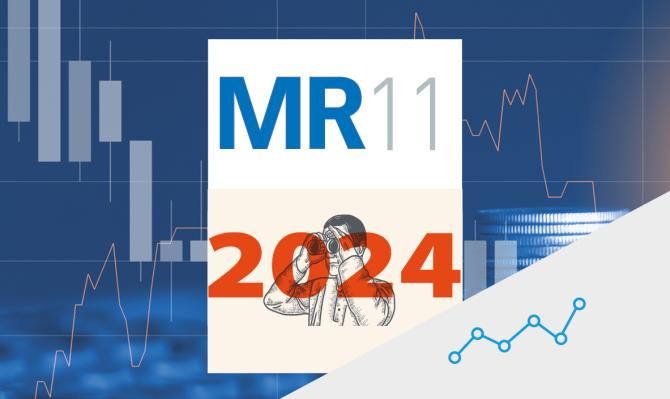Monetary policy on «pause»

The final stretch of the year began with two major catalysts. The first was the outbreak of a new source of geopolitical instability, namely the conflict between Israel and Hamas, which initially generated a spike in volatility in most assets and increased investor caution. As the weeks drew on, and despite the region’s potential for destabilisation in the event of further escalation, investors’ nerves were calmed by the apparent local nature of the conflict and attention shifted to the major central banks (the second catalyst). First the ECB and then the Fed agreed to leave their official rates unchanged in October. This reinforced the view that the monetary tightening cycle has reached its peak and served as an incentive for a recovery in risk appetite among investors, albeit a rather tepid one.

Unlike Russia’s invasion of Ukraine, commodity prices, and especially energy prices, did not buckle in the face of the initial shock of the crisis in the Middle East. This is partly due to the fact that none of the countries involved in the conflict are major producers of primary resources and that the current international monetary context (with interest rates remaining higher for longer) helps to cushion a price rally through lower demand. However, prices remained volatile in the face of the heightened uncertainty and due to the fact that, if the conflict were to spread to more countries, it would have a greater impact on the production and commercial transit of some energy products. While the price of a barrel of Brent initially rose but then dropped back down again to around the level
at which it had begun the month, the price of natural gas (Dutch TTF) increased to the levels of eight months ago, also driven by external factors of temporary nature (such as the sabotage of a gas pipeline in Finland and strikes at a gas company in Australia).

After over a year of interest rate hikes and tighter financial conditions, the major advanced economies have begun to show clear signs of cooling, mainly through their inflation rates. Although these rates are still higher than desired by their respective monetary authorities, the fact that the disinflationary pattern has been both pronounced and sustained was a key factor in the major central banks’ decisions to pause the cycle of rate hikes at their latest meetings. However, they are still far from declaring victory in the fight against inflation, and in this regard they reiterated a restrictive bias and their intention to keep rates high for some time. Thus, at its October meeting the ECB left interest rates at the levels already set in September (the depo rate at 4.00% and the refi rate at 4.50%). The Fed, meanwhile, kept rates at 5.25%-5.50%, and although it acknowledged that financial conditions have continued to tighten, it left the door open to further rate rises given the strength of the US economy. In both cases, financial markets interpreted the pauses as an end to the cycle of rate hikes on both sides of the Atlantic. In other advanced economies, the central banks of Canada and England also chose to keep their rates unchanged at 5.00% and 5.25%, respectively. The counterpoint was provided by the Bank of Japan, which despite its highly expansionary policy took a small step towards withdrawing its yield curve control policy (the Bank of Japan sets a «ceiling» of 1.0% for the 10-year sovereign rate, but from now on it is likely to treat this threshold with greater flexibility, formally considering it only a «benchmark»).


In the sessions leading up to the Fed and ECB meetings, and despite the geopolitical uncertainty, the expectation of a monetary environment marked by rates remaining higher for longer was the main catalyst for the sovereign markets. In the US, this sentiment was reinforced with the publication of data that showed the economy remained resilient, triggering a surge in long-term bond yields: in the case of the 10-year treasury, the yield reached as high as 5% (momentarily) for the first time in 16 years. However, following the Fed meeting, the data published on the labour market showed a certain loss of traction and sovereign debt yields once again declined, alongside investors’ reduced expectations of further rate hikes by the Fed. In the euro area, on the other hand, the weak economic data led to a downward adjustment in short-term yields, while long-term yields were affected by contagion from the eventual decline in US sovereign rates. The risk premiums of Europe’s periphery countries narrowed, especially in the case of Italy after S&P kept its credit rating unchanged. In the currency markets, meanwhile, the dollar capitalised on the improvement in yields on its curve relative to that of the euro area and remained at around 1.05 against the euro.

Despite posting annual gains of 7%, the MSCI World Index fell by around 2% in October. This was a result of the confirmation of interest rates remaining higher for longer, both in advanced economies and the major emerging ones, as well as investor caution in the face of the instability triggered by some geopolitical risks. In addition, both factors coincided with the beginning of the Q3 corporate earnings season in the US and the euro area. Up until the end of October the picture has been mixed, as earnings have exceeded expectations by more than 70% in the case of the US, but the pace of their growth is the lowest of recent quarters and the outlook for 2024 looks less optimistic. On balance, these factors penalised the market capitalisation of the major Western stock markets, which lost 3% in the month on average, while those of emerging markets also fell despite the new monetary and fiscal stimuli in China.
